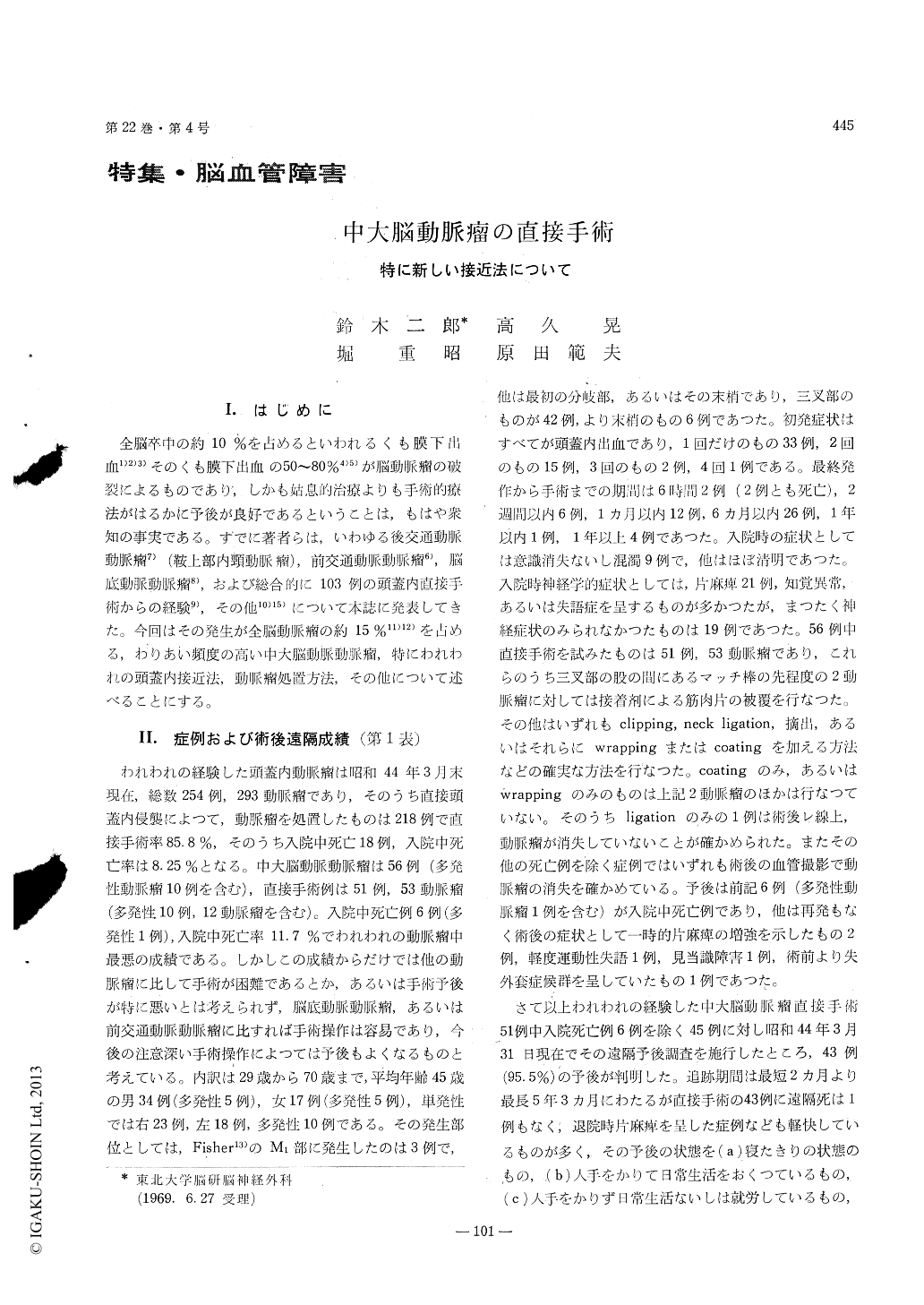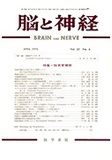Japanese
English
- 有料閲覧
- Abstract 文献概要
- 1ページ目 Look Inside
I.はじめに
全脳卒中の約10%を占めるといわれるくも膜下出血1)2)3)そのくも膜下出血の50〜80%4)5)が脳動脈瘤の破裂によるものであり,しかも姑息的治療よりも手術的療法がはるかに予後が良好であるということは,もはや衆知の事実である。すでに著者らは,いわゆる後交通動脈動脈瘤7)(鞍上部内頸動脈瘤),前交通動脈動脈瘤6),脳底動脈動脈瘤8),および総合的に103例の頭蓋内直接手術からの経験9),その他10)15)について本誌に発表してきた。今回はその発生が全脳動脈瘤の約15%11)12)を占める,わりあい頻度の高い中大脳動脈動脈瘤,特にわれわれの頭蓋内接近法,動脈瘤処置方法,その他について述べることにする。
We have performed intracranial direct operation for the intracranial aneurysm upon 218 cases of 254 cases in our series until the end of March, 1969. Eighteen cases died during hospitalization after operation, subsequently the mortality rate during hospitalization was 8. 2%.
The number of the cases in which were performed intracranial direct operation for the aneurysm of the middle cerebral artery was 51 (including 10 cases of multiple aneurysm), and the number of aneury-sms of this artery were 53. The number of death during hospitalization after operation was 6, sub-sequently the mortality rate during hospitalization was 11. 7%, which was the highest among the mor-tality rate for the sites of the intracranial aneurysm of our series.
The follow up study was performed on our 45 cases of aneurysm of middle cerebral artery except 6 postoperative death cases.
The prognosis of 43 cases which were followed during 2 months to 5 years 3 months postoperativelywas revealed.
The follow up ratio was 95. 5%.
There was no death cases after discharge, but 1 case in bad condition.
The other 42 cases were healthy at the end of March, 1969
Postoperative death cases :
Case 1 was in coma before operation in which clipping of the aneurysmal neck and evacuation of hematoma was carried out. He never regained con-sciousness and died 3 days after operation. Case 2 died due to postoperative intracerebral hematoma which was formed by cerebral squeezing during operation. Case 3 was unconscious before operation in which evacuation of hematoma and extirpation of aneurysm were performed. He died 3 days after operation without regaining consciousness. Case 4 died due to thrombi which might be released from the aneurysmal sack during operative procedure. Case 5 with two aneurysms of basilar artery and right middle cerebral artery died postoperatively due to rupture of the small aneurysm which was near the main aneurysm of the basilar artery and was not recognized during operation. Case 6 died 6 days after operation inspite of his postoperative recovery.
In this case, rupture of the aneurysm occured during surgery and only the neck ligation without clipping was performed under hypothermic anesthe-sia. Though the autopsy could not be performed, it seems to us that the re-bleeding from ruptured aneurysm due to insufficient ligation might be the cause of his death.
Operative method :
At first, the keel form incision at temporal region, as an approach to the aneurysm of the middle cere-bral artery was adopted by us. Next, usual fronto-temporal craniotomy was performed, Finally a linear incision about 6 cm long on the temporal region which was newly designed was tried and found to be most simple and rational.
Sylvian fissure is dissected bluntly and the stem of the middle cerebral artery is exposed. The neck of the aneurysm is dissected carefully and com-pletely. Clipping or clipping after ligation is the usual method of us. Only coating or only wrapping is rarely used only when the size of aneurysm is very small at the bifurcation of arteries.
Anesthesia :
Hypothermic anesthesia is necessary. Normother-mia is also available. But under normothermia, the stem of middle cerebral artery can not be clipped temporarily safely, when rupture of the aneurysm takes place. So the hypothermic anesthesia is prefered.
Timing of surgery :
Early operation is our policy when the patient is alert. Even though the patient has severe vas-ospasm, operation should be performed if he is not in coma or is taking a down hill course.

Copyright © 1970, Igaku-Shoin Ltd. All rights reserved.


